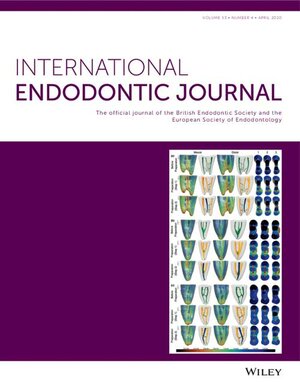Long-term prognosis for teeth with external cervical resorption based on periapical images and cone beam CT: A clinical study
Abstract
Aim
To evaluate whether supplemental information from CBCT changed long-term prognosis for teeth with external cervical resorption (ECR) compared to periapical (PA) images. Furthermore, to assess predictive findings in PA images and evaluate which findings in CBCT affected the long-term prognosis of teeth with ECR.
Methodology
One hundred and ninty-four patients, mean age 41.2, range 13–81, having 244 teeth with ECR were included. An initial long-term prognosis determined either good or poor was established based on intraoral images. Afterwards, the patients underwent CBCT, and final long-term prognosis was decided. From the PA images and CBCT, ECR using Heithersay's classification system, pulp involvement and extension of ECR was assessed. In CBCT, the number of surface lesion(s) was additionally assessed. Descriptive statistics evaluated changes in long-term prognosis after CBCT. Logistic regression analyses tested if findings in PA images and CBCT affected the long-term prognosis.
Results
Based on CBCT, out of 244 teeth the long-term prognosis was assessed to be poor for 173 (70.9%) teeth and good for 71 (29.1%) teeth. The long-term prognosis changed in 76 (31.1%) teeth after CBCT; 5 (2.0%) changed from poor to good, and 71 (29%) changed from good to poor long-term prognosis. In 81 (33.2%) teeth the H-class increased, and in 10 (4.1%) teeth the H-class decreased after assessing CBCT. In 70 (28.7%) teeth, there was a change from no pulp involvement to involvement of the pulp after CBCT; eight (3.3%) teeth changed in the opposite direction. H-class 2 and 4 in PA images significantly increased the probability for a change in long-term prognosis compared to an H-class 3 (p < .05). H-class 4, pulp involvement, ECR in the oral 1/3 of the root, and more than two surface lesions seen in CBCT significantly influenced a poor long-term prognosis (p < .05).
Conclusions
Supplemental information from CBCT changed long-term prognosis in almost one third of teeth with ECR. In most cases, the long-term prognosis changed from good to poor. H-class 3 in PA images had a significant influence on change in long-term prognosis. Several findings in CBCT influenced a poor long-term prognosis.


 求助内容:
求助内容: 应助结果提醒方式:
应助结果提醒方式:


